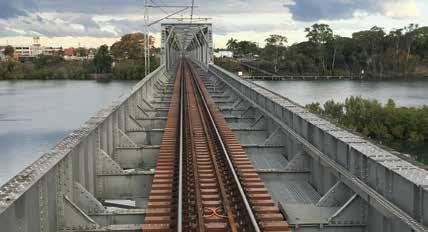
3 minute read
Sekisui sleepers approach 40 years of action
from REX Dec 2019
by Prime Group
Synthetic sleepers going strong 39 years on
Synthetic sleeper manufacturer, Sekisui Chemical Co., Ltd. is bringing a sleeper recently extracted from service after 30 years to AusRAIL to show visitors how well the company’s polymer technology has held up.
AS RAIL NETWORKS HAVE GROWN in Australia and New Zealand, the sector has become more focused on not only the capital cost, but also the ongoing cost of maintaining its fixed assets. This is the trend targeted by Sekisui with its Fiber reinforced Foamed Urethane (FFU) sleeper. The company’s marketing manager for Asia Pacific and the Americas Masaki Hayashi says the sleepers are workable like wood, but last significantly longer.
“The difference between timber and FFU is that FFU has longevity,” Hayashi said. “FFU doesn’t rot like timber, and it comes with uniform quality. When you work with timber, it’s very difficult to obtain uniform quality over a large batch.”
A follow-up survey of FFU synthetic sleepers after 30 years in service, conducted in 2011 by Railway Technical Research Institute (Japan), suggested the expected life of an FFU sleeper is around 50 years. Sekisui will have one example of an FFU sleeper with 30 years of service logged at AusRAIL PLUS. Next year the company plans to pluck another from the field, to testing after 40 years of service.
“While timber might last that long under specific circumstances, it will depend a lot on the environment and the usage,” Hayashi said.
The primary benefit of this longevity is the elimination of costs associated with reinstalling timber sleepers over the long term.
“Installation costs including labour, track equipment and safety measures costs are generally higher than material costs, so with a lifecycle cost of 50 years without replacement, FFU works out much better than natural timber in many applications,” Hayashi explains. “A natural not protected timber sleeper in some environments may have to be replaced up to
seven times during the lifetime of a FFU sleeper.” The core design feature of an FFU sleeper is its collection of continuous glass fibres which run from one end to another. These fibres reinforce the thermosetting resin foam comprised of rigid urethane resin, which is poured over the glass fibres and then sets during the manufacturing process.
The benefit of using FFU is to enjoy both the features of natural wooden sleepers and those of plastics. The FFU sleepers are a similar weight to natural lumber. Bending strength is stronger than natural lumber, and maintains this strength for a long period FFU manufacturing process means sleepers can be fabricated to a specific height, width, and length.
You can visit Sekisui at AusRAIL PLUS at Delkor Rail’s stand, Stand 190.
Contact: contact@sekisui-rail.com Web: www.sekisui-rail.com Shinkansen platform at Osaka station.
Bridge in Queensland.
Caption right

Holistic Training Solutions CERT is a Registered Training Organisation (RTO ID 51333) with offices and trainers strategically placed nationally in all mainland states to ensure compliant, responsive and cost effective services to national clients. CERT has the ability to mobilise personnel and business processes nationally as required. Contact us on 1300 042 378 or visit cert.edu.au to find out more.


NEW WEBSITE COMING SOON Training Packages Include: Certificate II - III Track Protection Certificate II - IV Rail Infrastructure Certificate IV in Train Driving Certificate II - III Tram or Light Rail Infrastructure Certificate IV in Rail Safety Management Certificate IV Rail Network Control Certificate III Mobile Crane Operations High Risk Licencing: Forklift and EWP Cranes, Dogging and Rigging Working at Heights and Confined Spaces Fire and First Aid Services Include: Skills Audit Courseware development Rule Book Development Developing of Safeworking Systems Worksite Audits Rail Safety Management International Consultancy Training: Network Control Rail Infrastructure Workers (Track Maintenance, Track Construction, Track Machine and Welding) Train Driver (Terminal, Mainline, Heritage and Steam Locomotives) Yard Shunting and Coordination










